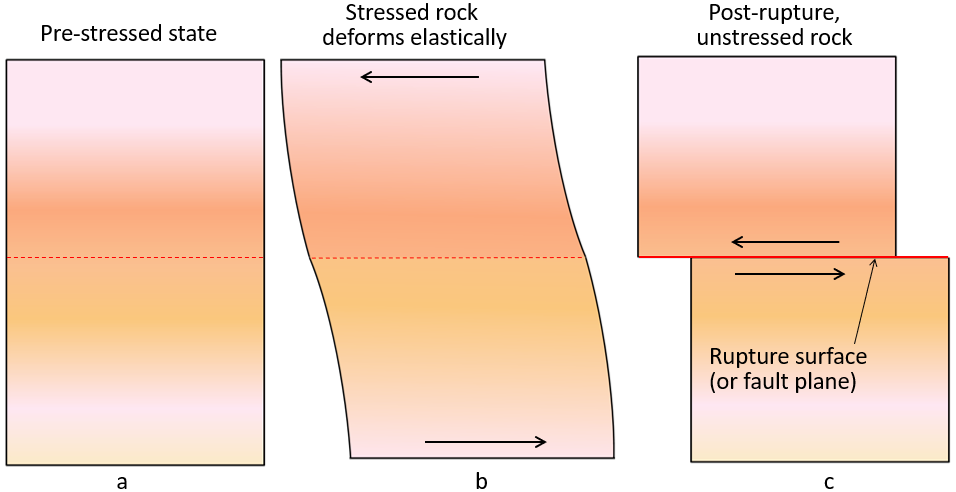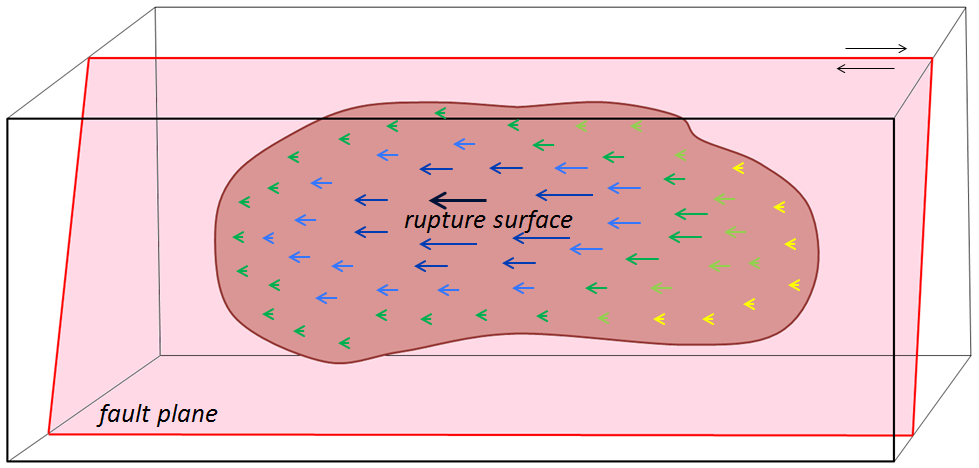5.1 Causes of Earthquakes
Merry Wilson
An earthquake is defined as the shaking of the ground, due to movements in the Earth’s crust. The movements, usually caused by plate tectonics, apply stress to rocks, which initially cause the rocks to deform elastically, storing the stress. Once enough stress is applied, the rocks will rupture (break) and release the stored energy, causing an earthquake (Fig. 5.1.1). Most earthquakes are confined to plate boundaries, but earthquakes can also occur from volcanic activity or from catastrophic landslides. The shifting and displacement of rocks occurs along the rupture surface, also referred to as a fault plane. The line where the fault plane intersects the Earth’s surface is called a fault or fault scarp. All earthquakes cause a rupture surface, but not all of them can be seen as a fault on the surface.

The concept of a rupture surface is illustrated below (Fig. 5.1.2). An earthquake does not happen at a single point, it happens over an extended area. It also doesn’t happen all at one time! The extent of a rupture surface and the amount of displacement will depend on several factors, including the type and strength of the rock, and the degree to which it was stressed or altered beforehand.

Foreshocks and Aftershocks
Foreshocks are small earthquakes that precede a larger event. As previously mentioned, hundreds of thousands of earthquakes occur yearly as plates release stress and rupture, not all of these are foreshocks. In order to be considered a foreshock, a larger event must occur in the same area. Special attention is paid to swarms (groupings) of foreshocks in an area, as they may signify a larger event will occur. Aftershocks are also earthquakes, but they have been triggered by stress transfer from a preceding earthquake and they occur within the original rupture surface.
Video 5.1.3. The animation shows foreshocks, mainshocks and aftershocks locations in relation to the rupture surface during and earthquake (00:16)
Aftershocks can be of any magnitude, but most are smaller than the earthquake that triggered them. Many aftershocks occur within seconds or minutes of the mainshock, but they can occur over days, weeks, months, or years. Figure 5.1.4 shows the distribution of aftershocks within the first 4 days of the devastating 9.0 earthquake of 2011 in Japan. The large yellow circle is the main earthquake event, and the rest of the circles represent aftershocks in the area of the fault. Though the main earthquake released a tremendous amount of energy and relieved stress on that part of the fault, a resulting increase in stress on nearby parts of the fault system contributed to the multiple aftershocks. Hundreds of aftershocks were recorded within a few days, and thousands have occurred since the original quake event.

Stress Transfer
As already noted, aftershocks are related to stress transfer. For example, the main shock of the 9.0 earthquake in Japan in 2011 triggered aftershocks in the immediate area, which triggered more in the surrounding area, eventually extending along the fault plane in all directions. The earthquake, inclusive of aftershocks, also changed the stress on adjacent parts of the fault zone. Though the aftershocks all occur on the original rupture surface, stress transfer isn’t restricted to the fault along which an earthquake happened. It can affect the rocks around the site of the earthquake and may lead to increased stress on other faults in the region. The effects of stress transfer don’t necessarily show up right away. Segments of faults are typically in some state of stress, and the transfer of stress from another area is only rarely enough to push a fault segment beyond its limits to the point of rupture. The stress that is added by stress transfer accumulates along with the ongoing buildup of stress from plate motion and eventually leads to another earthquake (5).
Digging Deeper: Earthquakes only occur on Earth!

Really, we’re talking about the concept of “quakes” – the release of stored energy due to the movement of rocks. They are only “Earthquakes” because they occur on Earth.
- Moonquakes occur, and were first detected by the Apollo astronauts. Scientists believe that they are generated by the shrinking of the Moon. As the interior cools, the Moon shrinks, causing small ruptures to occur and quakes to be generated. Faults can be seen on the surface of the moon!
- Marsquakes have also been detected by NASA scientists! With more advancing missions to Mars, future marsquakes will become more intensively studied. Mars has had active volcanism in its past, and is thought to have a molten core, which may account for the quakes.
The theory that the outer layer of the Earth (the lithosphere) is broken in several plates, and these plates move relative to one another, causing the major topographic features of Earth (e.g. mountains, oceans) and most earthquakes and volcanoes.
the point on the earth's surface that is broken due to earthquake movement
An area of breakage or rupture between at least two units of rocks that allows them to move relative to one another.
earthquakes that precede larger earthquakes in the same location
an earthquake triggered by stress transfer from a preceding earthquake

